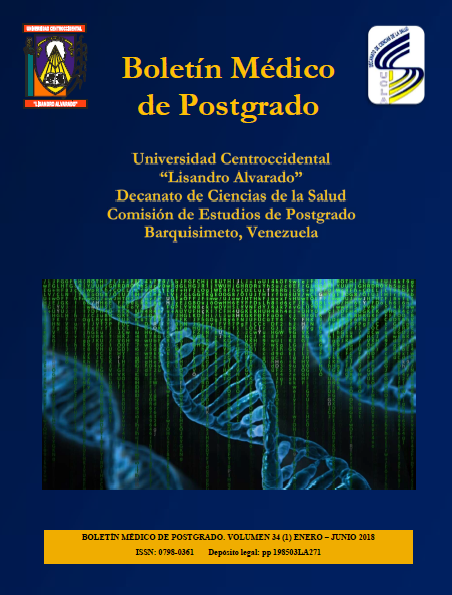Evaluation of hemodynamic stability in patients undergoing abdominal surgery treated with morphine during anesthesia induction
Keywords:
Morphine, hemodynamic parameters, abdominal surgery, anesthesia inductionAbstract
Opioids are the most potent drugs used to mitigate the chronotropic and vasoconstrictor effects that occur during laryngoscopy. A cross-sectional descriptive study was conducted in order to evaluate the hemodynamic stability of morphine during anesthetic induction in patients undergoing abdominal surgery in the Hospital Central Universitario Dr. Antonio María Pineda. The sample included 30 patients with an average age of 38 ± 14.63 years predominantly male (56.67%) and ASA II (53.33%). 40% of patients underwent cholecystectomy and 20% umbilicoplasty and 16.67% inguinal hernia repair. During anesthesia induction, 26.7%, 10% and 50% of patients showed an increase in systolic, diastolic and mean blood pressure > 20 mmHg compared to basal values. Five minutes post induction, all patients showed decreased values of systolic and diastolic blood pressure and only 10% of patients showed changes in mean arterial blood pressure. No adverse effects were recorded. These results show that morphine at a dose of 0.1 mg/kg intravenously 30 minutes before induction allows greater comfort for the patient with minimal hemodynamic changes and no adverse effects.
Downloads
References
2. Correa A, Castillo V, García A, González A, Bazart P. Analgesia postoperatoria con morfina base en cirugía abdominal. Revista Ciencias Médicas 2004; 8(1): 3-12.
3. Hudcova J, McNicol E, Quah C, Lau J, Carr D. (2007). Analgesia opioide controlada por el paciente versus analgesia opioide convencional para el dolor postoperatorio (Cochrane Review). En: La Biblioteca Cochrane Plus, Issue 4, 2007. Oxford: Update Software. pp. 214-2018.
4. García J, Jiménez F, Arnaud M, Ramírez Y, Lino L. (2011). Introducción a la Metodología de la Investigación en Ciencias de la Salud. McGraw-Hill, Interamericana Editores, S.A. Primera Edición, México; 2343-345.
5. Boza J, López J. (2013). Uso terapéutico de la morfina en el alivio del dolor posoperatorio. Disponible en: http://www.monografias.com/trabajos95/uso-terapeutico-morfina-alivio-del-dolor-posoperatorio/uso-terapeutico-morfina-alivio-del-dolor-posoperatorio.shtml#referencia#ixzz3d4NlQfdT. (Consulta; 2015, junio 12).
6. Bijur P. Response to morphine in male and female patients. Analgesia and adverse events. Clin J Pain 2008; 24 (3): 192-98.
7. Cruz S, Ramos L, De La Cruz I, Campos M. Analgesia postoperatoria con el uso de morfina liofilizada. Revista Cubana de Anestesiología y Reanimación 2013; 12(2): 129-138.
Published
How to Cite
Issue
Section
Las opiniones expresadas por los autores no necesariamente reflejan la postura del editor de la publicación ni de la UCLA. Se autoriza la reproducción total o parcial de los textos aquí publicados, siempre y cuando se cite la fuente completa y la dirección electrónica de esta revista. Los autores(as) tienen el derecho de utilizar sus artículos para cualquier propósito siempre y cuando se realice sin fines de lucro. Los autores(as) pueden publicar en internet o cualquier otro medio la versión final aprobada de su trabajo, luego que esta ha sido publicada en esta revista.



